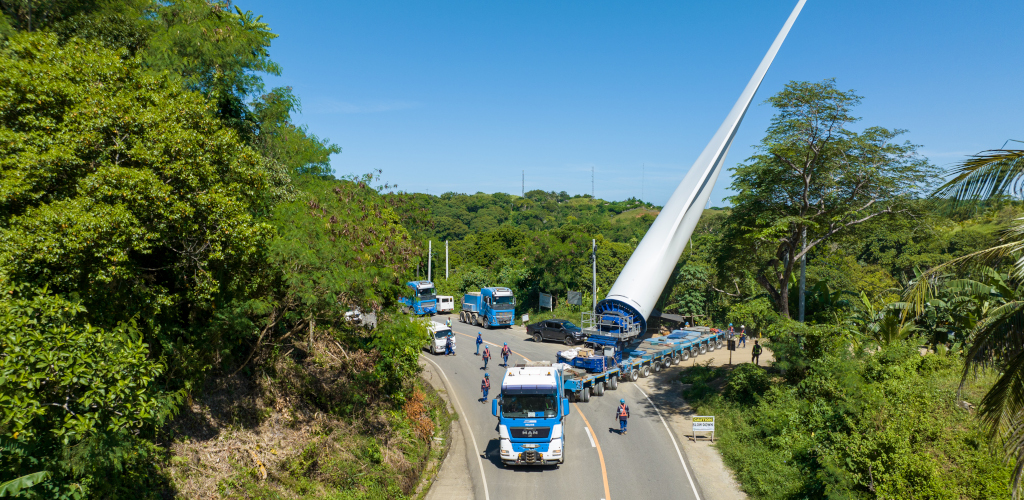Nation Is Poised to Be a Significant Renewable Energy Market in Asia

By Thomas Timlen
Despite the challenges posed by its terrain and infrastructure limitations, the Philippines has made significant inroads in developing its renewable energy capacity. As more projects are given the green light, opportunities will grow for ocean carriers, barges and specialized equipment providers, especially in the wind sector.
From Issue 3, 2024 of Breakbulk Magazine.
(5-min read)
Would-be regional leader the Philippines has the ambition to increase the share of renewable energy in its energy mix to 35 percent by 2030 and to 50 percent by 2040, up from the current share of 20 percent.
In pursuit of these goals in the coming years, suppliers of project cargo transportation services stand to benefit from a steady stream of opportunities, not limited to the movement of onshore and offshore turbine components, but also from ongoing initiatives to enhance and expand the nation’s transportation and energy infrastructure.
Among ASEAN countries, the Philippines is well positioned to continue its renewable energy journey, as Janna E. Smith, a researcher at Global Energy Monitor tells Breakbulk.
“Global Energy Monitor’s Global Solar and Wind Power Trackers have cataloged more than 3 GW of operating utility-scale solar and wind capacity in the Philippines, the third largest capacity among ASEAN countries. The Philippines is also the eighth largest in the world for total prospective utility-scale solar and wind capacity combined, with 99 GW in either announced, preconstruction, or construction phases.”
The Philippines has achieved notable progress in the past in its pursuit of enhancing sustainable energy, despite the challenges posed by its terrain and infrastructure limitations. Looking ahead, the same innovations adapted to overcome past challenges will play a role in the further expansion work that lies ahead. Dimerco Express’ Director of Ocean Freight, Dick Jimenez, briefed Breakbulk on approaches that have proven useful.
Physical Challenges
 “In light of the Philippines’ wind power initiatives driven by the government’s commitment to cleaner energy sources, the movement of this project cargo presents both challenges and innovative solutions within the country’s diverse landscape,” said Jimenez.
“In light of the Philippines’ wind power initiatives driven by the government’s commitment to cleaner energy sources, the movement of this project cargo presents both challenges and innovative solutions within the country’s diverse landscape,” said Jimenez.
“Given the archipelagic nature of the Philippines with numerous islands, mountainous terrains and remote locations where wind power projects are often situated, transporting project cargo poses logistical complexities. However, the use of modern equipment allows the delivery of oversized cargo, despite these challenges. In regions like Visayas, where large-scale wind power projects are prevalent, options such as RoRo ships and chartered vessels cater to the transportation needs of sizable cargo. Additionally, the deployment of barges facilitates cargo delivery to remote islands.
“In Luzon, a key region for industrial and infrastructure development, the transportation of heavy and oversized cargo is facilitated by a fleet of modern multi-axle trucks equipped with super-low bed chassis and other advanced features. These vehicles navigate through varied terrains delivering cargo to its destinations.”
In practice, Dimerco has moved a wide range of oversized and heavy freight to remote areas in Batangas by utilizing multi-axle trucks with remote control super low bed chassis, even in areas lacking paved roads.
One transportation stakeholder in the Philippines with a track record directly linked to the wind sector is Royal Cargo. The company’s Senior Vice President for Projects and Heavylift/Crane and Erection Division, Rodrigo “Toddy” A. De Roma, informed Breakbulk that the company has proven its expertise in transporting wind turbine generator components, successfully handling transportation projects for wind farms including the 32-turbine Balaoi & Caunayan, the 6-turbine Nabas II and the 14-turbine Caparispisan II projects.
“In response to the emergence of third-generation wind turbine generators with blades spanning up to 95.5m, Royal Cargo stands up to the challenge by providing comprehensive end-to-end solutions for clients,” said De Roma. “Our fleet includes specialized prime movers, trailers, cranes, lifting equipment, blade lifters and trailers specifically designed for oversized and heavy cargo.”
Clean Energy Goals
The new energy initiatives will require significant financing. The Organisation for Economic Co-operation and Development (OECD) has estimated that the Philippines will need investments amounting to US$337 billion by 2040 to achieve its clean energy goals.
Despite advantages such as optimal terrain and location for wind power, a lack of related policy and restrictions on foreign ownership and investment seemed to have restricted growth in the sector. Recent policy adjustments appear to be addressing these issues.
One example of an easing of foreign ownership and investment restrictions is seen with the Australian-based global financial services firm Macquarie Group Ltd., which has expressed interest in investing in the Philippines’ renewable energy.
Macquarie is a global financial services group operating in 34 markets, specializing in areas such as resources, agriculture and commodities, energy and infrastructure, with a track record in the Asia-Pacific region. It has been operating in the Philippines for over 15 years, with more than 1,000 direct employees through Macquarie Offshore Services, which supports the company’s global business across operations, finance, technology and risk management.
Macquarie has direct experience in the country, having won a bid in 2021 to manage the first and largest-ever infrastructure fund for the Philippines. Subsequently, a Macquarie Asset Management-led consortium acquired a majority stake in Energy Development Corporation (EDC), the Philippines’ largest renewable energy company.
Alongside the easing of foreign ownership restrictions on renewable energy development, there has also been movement involving foreign companies obtaining Wind Energy Service Contracts (WESCs). The Department of Energy (DOE)’s data shows that it has issued 21 WESCs to foreign-owned companies, 17 of which are onshore projects and four that are offshore wind energy projects.
The contracts provide Dublin-headquartered Mainstream Renewable Power with exclusive development rights for two onshore wind projects; the 100 MW Santa Ana Cagayan Wind Project located in the Municipality of Santa Ana, Cagayan Province and the 340 MW Panaon Wind Project located on Panaon Island in the Leyte Province. The projects, which have already commenced early-stage development activities, are about 500 kilometers from the capital city, Manila.
The DOE’s Energy Secretary Raphael P.M. Lotilla said: “With the Philippine economy now thriving, marked by good growth and optimistic forecasts, we are pleased with the positive response of foreign and local investors to pour in capital in our country’s renewable energy sources.
“Mainstream will be bringing in financial muscle and technological heft to work with our world-class workers throughout the construction and operational phases of all these projects, which means more employment for our people and livelihood opportunities in these areas.”
The Aboitiz Group, a conglomerate active in energy and infrastructure, confirmed in late March that it has earmarked US$2.6 billion as this year’s capital expenditure (capex), allotting a big chunk to renewable energy projects. In 2023 the group’s capex in renewable energy was US$1.1 billion, illustrating the scale of this year’s increase.
Transparent Policies
Key OECD recommendations to fast-track developments in energy efficiency include a harmonized implementation plan; public budget allocation for local government units; regulatory reforms; data collection and transparency; improved access to finance; and capacity building for local impact.
DOE Undersecretary Rowena Cristina Guevara said that addressing regulatory challenges and bureaucratic hurdles will encourage investments in clean energy projects in the Philippines, adding that the country needs to strengthen its mechanisms, monitor and evaluate its initiatives.
Global Energy Monitor’s Smith sees evidence of this happening in real time. “In order to facilitate this anticipated increased capacity, the Philippines’ government is working to implement transparent investment policies.
“For example, the recently implemented Green Energy Auction Program (GEAP) provides a platform for bidding on renewable energy projects. Domestic policies such as these, that prioritize renewable energy over fossil fuel-based energy supplies, signal the country’s commitment to renewable energy goals.
“Domestic and international investors’ continued interest in the Philippines’ renewable energy may in turn serve to reduce barriers to this new sector, and allow for lower levelized costs of energy (LCOEs). Likewise, the construction, transportation and renewable energy technology sectors across the Philippines are growing, and are critical to the success of the Philippines’ energy transition.”
Such efforts, however, are not without their challenges, Smith warns. “At present, only 3 percent of the Philippines’ 99 GW of prospective capacity is currently in the construction phase. Further, the Philippines’ energy mix continues to rely on fossil fuels, and needed updates to the country’s energy infrastructure are stalling renewable energy projects that are ready for grid integration.
“There is clear interest in building out the Philippines’ renewable energy sector, but the government must continue to develop supportive renewable energy policy in order to encourage further growth, and reach the country’s full renewable energy potential.”
In view of the project cargo sector’s ability to facilitate the numerous renewable energy projects to date, and the improvements that have been realized with respect to increased involvement of foreign investment and ownership, the prospects for continued opportunities as new projects come alongside the expansion of existing facilities and infrastructure all bode well for the industry.
TOP PHOTO: Royal Cargo remote transport operation of turbine blade. CREDIT: Royal Cargo
